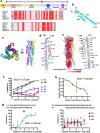Structural basis of HCoV-19 fusion core and an effective inhibition peptide against virus entry
- PMID: 32482145
- PMCID: PMC7448930
- DOI: 10.1080/22221751.2020.1770631
Structural basis of HCoV-19 fusion core and an effective inhibition peptide against virus entry
Conflict of interest statement
No potential conflict of interest was reported by the author(s).
Figures

Similar articles
-
Spike protein fusion loop controls SARS-CoV-2 fusogenicity and infectivity.J Struct Biol. 2021 Jun;213(2):107713. doi: 10.1016/j.jsb.2021.107713. Epub 2021 Mar 1. J Struct Biol. 2021. PMID: 33662570 Free PMC article.
-
Structure-guided engineering of a mutation-tolerant inhibitor peptide against variable SARS-CoV-2 spikes.Proc Natl Acad Sci U S A. 2025 Jan 28;122(4):e2413465122. doi: 10.1073/pnas.2413465122. Epub 2025 Jan 24. Proc Natl Acad Sci U S A. 2025. PMID: 39854234 Free PMC article.
-
Protein mimics of fusion core from SARS-CoV-1 can inhibit SARS-CoV-2 entry.Biochem Biophys Res Commun. 2024 Dec 3;736:150857. doi: 10.1016/j.bbrc.2024.150857. Epub 2024 Oct 20. Biochem Biophys Res Commun. 2024. PMID: 39490155
-
Research Progress on Spike-Dependent SARS-CoV-2 Fusion Inhibitors and Small Molecules Targeting the S2 Subunit of Spike.Viruses. 2024 Apr 30;16(5):712. doi: 10.3390/v16050712. Viruses. 2024. PMID: 38793593 Free PMC article. Review.
-
The biogenesis of SARS-CoV-2 spike glycoprotein: multiple targets for host-directed antiviral therapy.Biochem Biophys Res Commun. 2021 Jan 29;538:80-87. doi: 10.1016/j.bbrc.2020.10.080. Epub 2020 Nov 28. Biochem Biophys Res Commun. 2021. PMID: 33303190 Free PMC article. Review.
Cited by
-
A self-assembled trimeric protein vaccine induces protective immunity against Omicron variant.Nat Commun. 2022 Sep 17;13(1):5459. doi: 10.1038/s41467-022-33209-9. Nat Commun. 2022. PMID: 36115859 Free PMC article.
-
Structural conservation among variants of the SARS-CoV-2 spike postfusion bundle.Proc Natl Acad Sci U S A. 2022 Apr 19;119(16):e2119467119. doi: 10.1073/pnas.2119467119. Epub 2022 Apr 1. Proc Natl Acad Sci U S A. 2022. PMID: 35363556 Free PMC article.
-
Viral targets for vaccines against COVID-19.Nat Rev Immunol. 2021 Feb;21(2):73-82. doi: 10.1038/s41577-020-00480-0. Epub 2020 Dec 18. Nat Rev Immunol. 2021. PMID: 33340022 Free PMC article. Review.
-
Trivalent recombinant protein vaccine induces cross-neutralization against XBB lineage and JN.1 subvariants: preclinical and phase 1 clinical trials.Nat Commun. 2024 Dec 30;15(1):10778. doi: 10.1038/s41467-024-55087-z. Nat Commun. 2024. PMID: 39738039 Free PMC article. Clinical Trial.
-
Heterologous vaccination with subunit protein vaccine induces a superior neutralizing capacity against BA.4/5-included SARS-CoV-2 variants than homologous vaccination of mRNA vaccine.MedComm (2020). 2023 Mar 10;4(2):e238. doi: 10.1002/mco2.238. eCollection 2023 Apr. MedComm (2020). 2023. PMID: 36911160 Free PMC article.
References
Publication types
MeSH terms
Substances
LinkOut - more resources
Full Text Sources
Other Literature Sources
Medical
